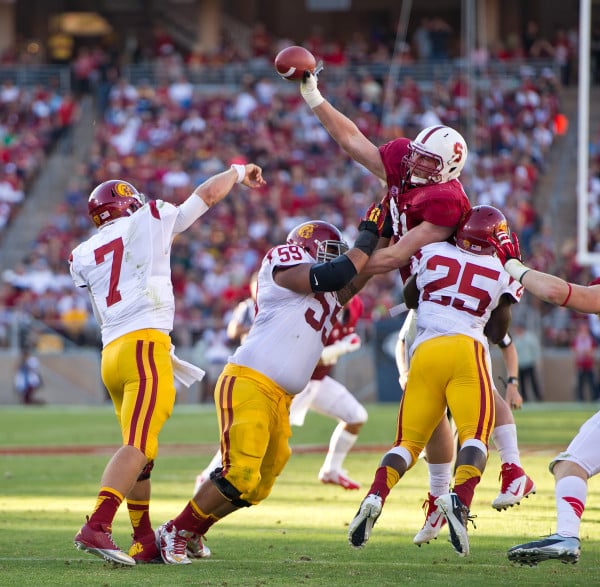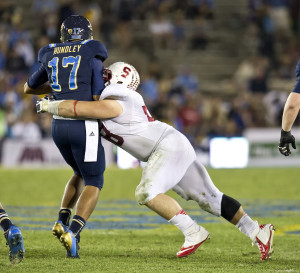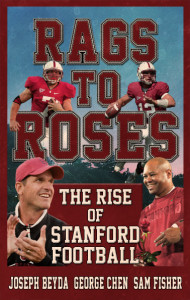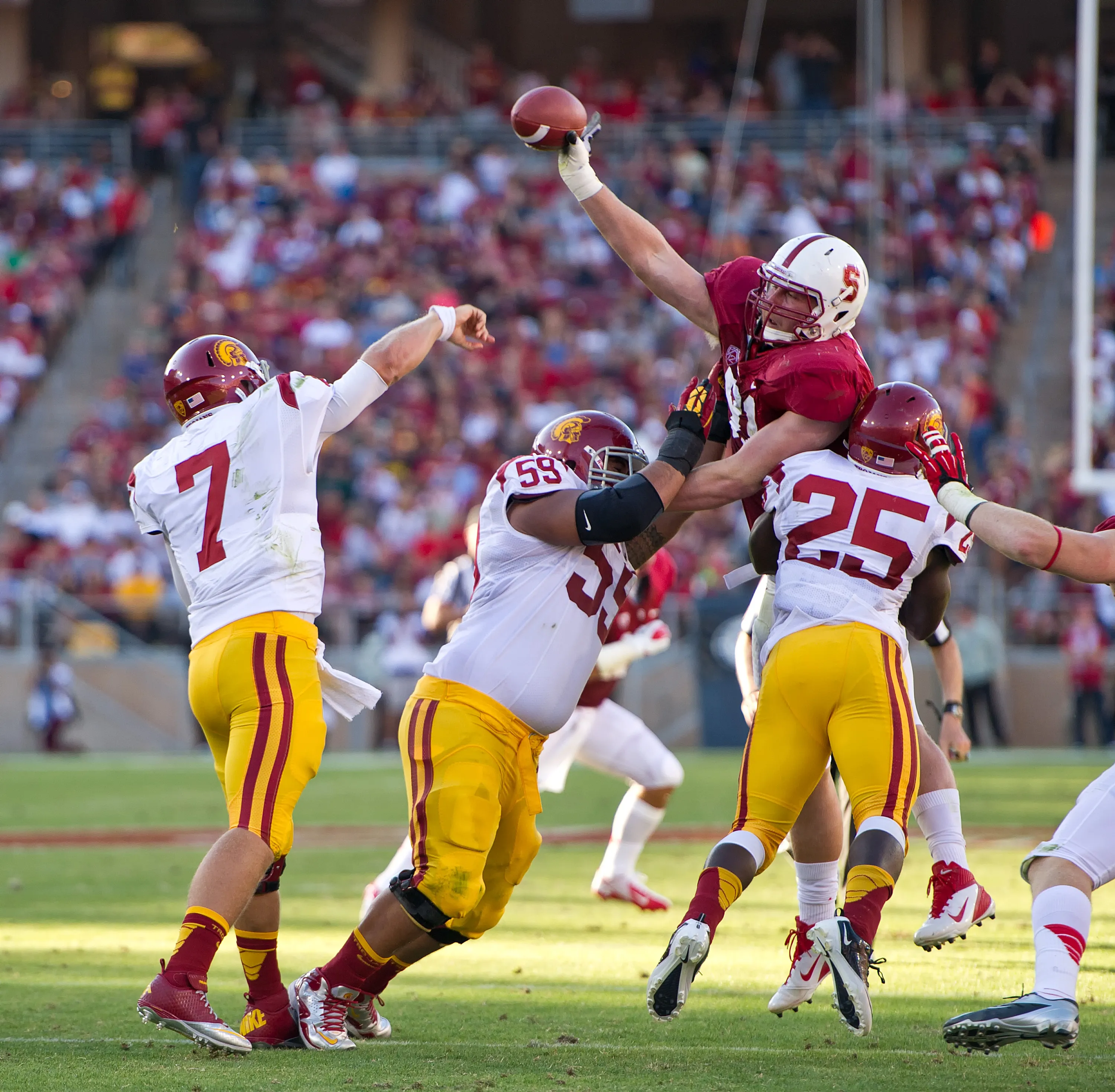It’s overtime at Stanford Stadium.
Down by 14 midway through the fourth quarter, quarterback Josh Nunes has calmly led the Cardinal on two touchdown drives — successfully converting two fourth downs in the process — to knot the score at 48 before the end of regulation. But after already inflicting over 600 yards of offense on Stanford’s tired defense, Arizona’s up-tempo attack is back on the field, getting the ball first in overtime.
The Cardinal can’t afford to lose this game — not after last week’s devastating loss to Washington on the road. Two consecutive defeats to Pac-12 teams would mean only one thing: Stanford could kiss its conference championship hopes goodbye.
Arizona quarterback Matt Scott drops back to pass on third-and-10. He’s thrown for 491 yards and three touchdowns on the day with a pinpoint accuracy that has frustrated the Cardinal defensive backs the entire afternoon. Why should this play be any different? Scott zips a pass toward the right side of the field.
The ball never reaches his intended target. Instead, it goes vertical.
Redshirt sophomore defensive end Henry Anderson had fought his way through a double team at the line of scrimmage. Knowing that he was too far away from Scott to take him down, he had jumped up with his right arm outstretched, deflecting the ball into the air and allowing outside linebacker Chase Thomas to make a leaping interception to end Arizona’s threat.
Two plays later, senior running back Stepfan Taylor ends the four-hour ordeal with a 21-yard touchdown run, giving Stanford a much-needed 54-48 overtime victory.
Anderson’s deflection of Scott’s pass was just one of the five pass breakups he recorded last season. Though his teammates jokingly dubbed him “Goose” because he failed to score a single point in a few games of Madden, that nickname also fittingly characterizes his on-field presence, considering how his freakishly long arms clog up passing lanes for opposing quarterbacks.

“I think [batting down passes] came a little bit naturally, and then we started to realize that it’s a pretty effective way to influence the game,” Anderson said. “If you can’t get to the quarterback, knock the ball down. That’s almost just as good.”
The Georgia native started all 14 games in 2012, but it was his impressive statistical production in the second half of the season — 11.5 of his 13.0 tackles for loss and 4.5 of his 5.5 sacks came after the seventh game — that earned him All-Pac-12 second team honors in addition to his Pac-12 All-Academic status. Anderson’s late surge proved critical at opportune times. Against Oregon on the road, he collected 2.5 tackles for loss, and against UCLA in the Pac-12 Championship Game, he recorded five solo tackles.
“The first few games, I was feeling it out a little bit — a little nervous,” Anderson said. “But as the season went along I got more comfortable with the playbook and just playing on Saturdays against other big-time teams. It was just a matter of comfort. It wasn’t even really the halfway point, where everyone talks about my production skyrocketing that second half of the season. It was only a few games in where I started feeling really comfortable, and I played well after those first few games.”
Anderson’s increasing confidence and comfort level with the playbook showed after the first three games of the season, even if his stat line wasn’t filled with tackles for loss and sacks right away. After notching just four tackles in the first three games of the season, he broke out with 14 total tackles in the next two contests against Washington and Arizona.
Standing at 6-foot-6 and just under 280 pounds last year, Anderson was already an intimidating physical specimen to behold. But on the first day of 2013 fall camp, head coach David Shaw hinted at an even stronger and faster Anderson Version 2.0.
“I wanted to gain some weight and play stronger against double teams,” Anderson said. “I kept gaining weight, and I felt like I was still moving well and changing direction well. I’m at 295 now; that’s where I’m probably going to stop, just because going against some of the spread teams, getting any bigger might harm my conditioning.”
Not only did Anderson gain nearly 20 pounds during the offseason, but he also improved his 40-yard dash time by focusing on agility work under the guidance of sports performance coordinator Shannon Turley. When asked about Anderson’s ceiling, defensive line coach Randy Hart, now entering his 44th year as a collegiate coach, simply replied, “Look up. The sky’s out there.”
Last season Anderson was just one among many playmakers on a Stanford front seven that led the nation in both sacks (57.0) and tackles for loss (124.0). On the defensive line, the good news is that every player who saw playing time in 2012, with the exception of nose guard Terrence Stephens, is back. The experienced corps includes redshirt junior defensive end Josh Mauro, who made 6.0 sacks and 5.0 tackles for loss last year as a backup, and fifth-year senior defensive end Ben Gardner, who garnered All-Pac-12 second team recognition with 14.5 tackles for loss and 7.5 sacks. Having the most game experience among all the defensive linemen, Gardner has become an important leader for not only his position group, but the entire team.
“[Gardner’s] ahead of the pack because he — along with several other guys — is in his senior year,” Hart said. “He’s done a great job of putting himself out there and working hard, making it so that the rest of the team has confidence in him.”

Even the most recently named starter on the defensive line, senior nose guard David Parry, is hardly a newcomer. Though Stephens has left for the Cincinnati Bengals to show off his vocal cords, Parry didn’t miss a beat as the starter in the last three games of the 2012 season, including the Pac-12 Championship and the Rose Bowl, when Stephens was ruled ineligible because of secondary NCAA violations. So far in camp, both Shaw and defensive coordinator Derek Mason have raved about Parry.
“This offseason I just really wanted to come out and get better every day,” Parry said. “I had a goal to improve myself in one area — one specific area — each day. So that’s what it’s really all about: Come out with a plan and working your plan.”
“I feel a little bit more explosive, a little bit stronger out there too,” Parry added.
The Cardinal defensive line hardly lacks depth either, with Aziz Shittu, who appeared in five games last season as a true freshman, and redshirt freshman Jordan Watkins continuing to hone their skills.
It will be tough for Stanford’s defense to top its nation-leading statistics from last season, but as the unit gears up for another party in the backfield in 2013, one thing is clear: The defensive linemen hope to be the first guests invited.
Contact George Chen at gchen15 “at” stanford.edu.
The Daily’s football preview series will be back Tuesday, as we take a look at Stanford’s running backs, and Wednesday, as we explore the Cardinal’s wide receiver corps.
Previous installments in our 2013 football season preview:
Aug. 19: Upstart tight ends look to fill void left by Ertz, Toilolo
Aug. 14: Hogan embraces leadership role, ready to take the next step
Aug. 13: Offensive line powers forward, seeks new center
Aug. 2o: Tarpley, Skov and Murphy headline Stanford’s elite linebacker corps

